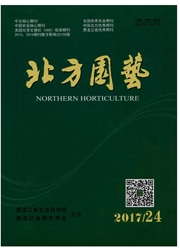

 中文摘要:
中文摘要:
以印度南瓜(母本,FP)、中国南瓜(父本,MP)及其种间杂交F1(印度南瓜×中国南瓜)代幼苗为试材,采用5℃低温处理幼苗2d,分别测定低温胁迫前后幼苗根系活力、电导率和丙二醛(MDA)含量以及保护酶活性的变化。结果表明:低温胁迫后F1代的根系活力最强,相对电导率最低,MDA含量最低,超氧化物歧化酶(SOD)、过氧化物酶(POD)和过氧化氢酶(CAT)活性最高,其次是母本印度南瓜,父本中国南瓜最低。这些生理指标的变化与砧木南瓜的耐寒性密切相关,即F1代的耐寒性最强,印度南瓜次之,中国南瓜最弱。
 英文摘要:
英文摘要:
Seedlings of Cucurbita maxima Duch(memale male parent, FP), Cucubita moschata Duch (mate parent, MP) and their hybrid F1 (C. maxima × C. moschata) were handled with low-temperature treatment (5℃, 2 days). Root activity, conductivity percentage, the malondialdelyote (MDA) contents, the activities of super oxygen dehydrogenises (SOD), peroxidase (POD) and catalase (CAT) were determined. The results showed that the root activity of hybrid F1 was the strongest,the conductance and the MDA content was the lowest. The activities of SOD,POD and CAT in root of hybrid F; were the highest,which was followed by C. maxima,C, moschata was the lowest. The changes of physiological index were closely related to chilling tolerance of pumpkin,that was,chilling tolerance of hybrid F; was the highest,next were C. maxima and C. moschata last.
 同期刊论文项目
同期刊论文项目
 同项目期刊论文
同项目期刊论文
 期刊信息
期刊信息
